ANCIENT GREEK RELIGIOUS BELIEFS
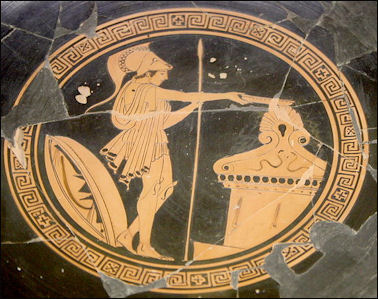
SacrificeMary Leftowitz, a classics professor at Wellesley College wrote in the Los Angeles Times, “As the Greeks saw it the gods made life hard for humans, didn't seek to improve the human condition and allowed people to suffer and die. As a palliative, the gods could offer only to see that great achievement were immortalized. There was no hope of redemption, no promise of a happy life or rewards after death. If things did go wrong, as they inevitably did, humans had to seek comfort not from gods but from other humans."
“The separation between humankind and the gods made it possible for humans to complain to the gods without the guilt and fear of reprisal the deity of the Old Testament inspired. Mortals were free to speculate about the character and intentions of the gods. By allowing mortals to ask hard questions, Greek theology encouraged them to learn, to seek all the possible causes of events, Philosophy---that characteristic Greek invention---had its roots in such theological inquiry, as did science."
“Paradoxically, the main advantage of ancient Greek religion lies in this ability to recognize and accept human fallibility. Mortals cannot suppose that they have all the answers, the people most likely to know what to do are prophets directly inspired by god, yet prophets inevitably meet resistance, because people hear only what the wish to hear, whether or not it is true. Mortals are particularly prone to error at the moments when they think they know what they are doing. The gods are fully aware of this human weakness. If they decide to communicate with the mortals, they tend to do so only indirectly by signs and portents which mortals often misinterpret...Greek religion openly discourages blind confidence based on unrealistic hopes that everything will work out."
There was no formal priesthood in Ancient Greece. There were leaders of local cults and priests who worked at specific temples, who were paid by donations to the temples.
Ancient Greek Temples
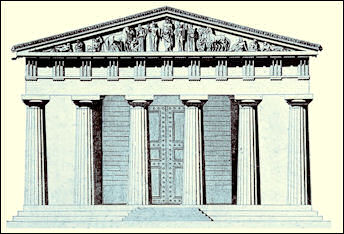
Temple of Zeus in OlympiaAncient Greek temples, unlike churches, were places the gods lived, not houses of worship. They were regarded as the home of cult statues and places where people could pay homage to gods and leave gifts for them. Some were only entered once or twice a year, and then only by the priest of the temple. Temples were built on hills, known as acropolises, apparently to impress outsiders coming to the city.
Greek temples were constructed to be admired from the outside. Ordinary people were often not allowed to go inside and if they were there usually wasn't much for them to see except for a large statue of the god the temple honored. On the outside statues were placed in niches. In a couple of instances the columns themselves were made into statues of women.
The Selinus Temple in Sicily was one of the largest Greek temples ever built. It is 362 feet long, 164 feet wide and has 48 columns made of 50 ton blocks that were hoisted 60 feet into the air. Because people often gathered outside a Greek temple rather than in interior could be relatively small. Temples usually features freestanding statues on pediments and relief panels carved into the stone that formed friezes around the building.
Ancient Greek temples were designed and constructed by craftsmen and decisions about column size and their location, it appears, were made when the building was being erected. According to Boorstin "scholars have not found a single architectural drawing." Most temples had a similar design and really the only creative work done by the architects was the artwork on the friezes and lintels. To construct a temple, Greek builders used ropes, pulleys and wooden cranes, as high as 80 feet tall, and sometimes used 25-foot-tall teamons, statues of a giant used as a support. Rough limestone columns were lifted and placed and then fluted by a stone cutter. [Source: "The Creators" by Daniel Boorstin,"]
On the purpose of Greek temples, Mary Beard wrote in The Times of London, “Forget any idea that temples were the centre of astronomically inspired rituals. Forget any idea that priests spent their time checking out the alignments of the stars. We need to think a bit more broadly about what Greek temples were for---and what they were not...They were not centres of ritual. Any ritual in the Greek world took place in the open air. They were not, like modern churches, mosques or synagogues, a place where a congregation gathered for worship...Greek priests were not specially trained religious, or scientific, experts. Many of them, in fact, were ordinary members of the upper class, who took on religious duties as a part-time extra." [Source: Mary Beard, The Times, November 19, 2009]
Temples had one main purpose only: to house an image of a god or goddess. The Parthenon in Athens, for example, was home for the huge gold and ivory statue of Athena Parthenos (Athena the Virgin), though it also had a back strong-room, where treasure and precious dedications to the goddess were stored.
see Architecture
Ancient Greek Temple Orientation
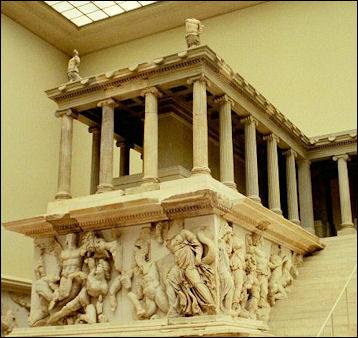
Pergamon AltarA study of Greek temples in Sicily by Alun Salt of the University of Leicester found the temples there were oriented towards the rising sun in the east. The issue of the ordination has long been an issue in the study of Ancient Greek. Most Greek temples were oriented toward the east but enough were oriented towards the west, south and north to leave the impression that orientation was not important. In Salt's study, 40 of the 41 temples he studied were oriented towards the east, the sole exception was a temple thought to be built in honor of the moon goddess.
On the matter of temple orientation Beard wroe, “Archaeologists have puzzled for more than a hundred years about the orientation of Greek temples. Even without any intricate calculations, it is fairly clear that most of them, though not all, were aligned East-West.Interestingly, the new research appears to show that the temples in the Greek colonies of Sicily are more closely aligned in this direction than their counterparts in Greece itself. It's a nice idea that the colonists were trying to be even more Greek than those Greeks they had left behind. After all, ex-pats throughout the world have almost always been particularly keen on their old native traditions.
So why did the Greeks generally choose to align the statue's house East-West? My guess is that they liked to place the god at the centre of the natural world, in line with the rhythms of night and day and the rising and setting of the sum.If an inconvenient marsh, or an awkward slope got in the way, they were happy enough to orientate the building in any direction. The famous temple of Bassae, for example, in the wilds of the Peloponnese stands north-south. \
In a study that aimed to figure out why temples were located where the were by taking into account geology, topography, soil type, vegetation and works by writers like Homer, Plato and Herodotus, University of Oregon professor Gregory Retallack could not find any kind or correlation except that between the god worshipped and the predominate soil type at the temple site. Retallack found fertile, well-structured soils call Xerolis were the dominant soil type at temples for Demeter, the goddess of fertility, and Dionysus, the god of wine. Rocky Orthent and Xerept soil were found at temples for Artemis, the virgin huntress and Apollo while Calcid soils, found in coastal areas too dry for agriculture, were found at temples for the maritime deities Poseidon and Aphrodite, the goddess of love.
Ancient Greek Religious Rituals

sacrificePurification rituals often featured animal sacrifices, libation of wines and wine drinking. Sacrificing a dog, cock or pig was seen as a sign of purification as was bathing in the sea. Apollo was depicted on vases as performing purification by dipping laurel leaves in the bowl most likely of pig's blood. Scapegoats were of form of purification. The term is traced back to Biblical times to describe a goat representing all the sins of the people was killed.
In some rituals initiates were covered in plaster and then coated again after they died so they would be recognized in the Underworld as someone with a ticket to paradise. Greek pilgrims that visited a temple dedicated to Aphrodite's son Eryx cavorted with prostitute-priestesses.
Religious cults had their own rituals. The cult that honored the mythical singer Orpheus performed purification rituals that promised a life in paradise after death. "Orphic purifiers traveled the countryside," a German scholar told National Geographic, "Those wandering charismatics had books of poems supposedly written by Orpheus and gold leaves bearing the instructions for getting through the Underworld ."
Wild Dionysus Festivals
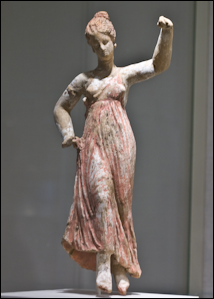 To pay their respect to Dionysus, the citizens of Athens, and other city-states, held a winter-time festival in which a large phallus was erected and displayed. After competitions were held to see who could empty their jug of wine the quickest, a procession from the sea to the city was held with flute players, garland bearers and honored citizens dressed as satyrs and maenads (nymphs), which were often paired together. At the end of the procession a bull was sacrificed symbolizing the fertility god's marriage to the queen of the city. [Source: "The Creators" by Daniel Boorstin,"]
To pay their respect to Dionysus, the citizens of Athens, and other city-states, held a winter-time festival in which a large phallus was erected and displayed. After competitions were held to see who could empty their jug of wine the quickest, a procession from the sea to the city was held with flute players, garland bearers and honored citizens dressed as satyrs and maenads (nymphs), which were often paired together. At the end of the procession a bull was sacrificed symbolizing the fertility god's marriage to the queen of the city. [Source: "The Creators" by Daniel Boorstin,"]
The word “maenad” is derived from the same root that gave us the words “manic” and “madness”. Maenads were subjects of numerous vase paintings. Like Dionysus himself they often depicted with a crown of iv and fawn skins draped over one shoulder. To express the speed and wildness of their movement the figures in the vase images had flying tresses and cocked back head. Their limbs were often in awkward positions, suggesting drunkenness.
_02.jpg) The main purveyors of the Dionysus fertility cult "These drunken devotees of Dionysus," wrote Boorstin, "filled with their god, felt no pain or fatigue, for they possessed the powers of the god himself. And they enjoyed one another to the rhythm of drum and pipe. At the climax of their mad dances the maenads, with their bare hands would tear apart some little animal that they had nourished at their breast. Then, as Euripides observed, they would enjoy 'the banquet of raw flesh.' On some occasions, it was said, they tore apart a tender child as if it were a fawn'"μ
The main purveyors of the Dionysus fertility cult "These drunken devotees of Dionysus," wrote Boorstin, "filled with their god, felt no pain or fatigue, for they possessed the powers of the god himself. And they enjoyed one another to the rhythm of drum and pipe. At the climax of their mad dances the maenads, with their bare hands would tear apart some little animal that they had nourished at their breast. Then, as Euripides observed, they would enjoy 'the banquet of raw flesh.' On some occasions, it was said, they tore apart a tender child as if it were a fawn'"μ
One time the maenads got so involved in what they were doing they had to be rescued from a snow storm in which they were found dancing in clothes frozen solid. On another occasion a government official that forbade the worship of Dionysus was bewitched into dressing up like a maenad and enticed into one of their orgies. When the maenads discovered him, he was torn to pieces until only a severed head remained."
It is not totally clear whether the maenad dances were based purely on mythology and were acted out by festival goers or whether there were really episodes of mass hysteria, triggered perhaps by disease and pent up frustration by women living in a male'dominate society. On at least one occasion these dances were banned and an effort was made to chancel the energy into something else such as poetry reading contests.
Other Ancient Greek Festivals
There were two major festival for Athenian women every year: The Thesmophoria promoted fertility and honored Persephone with piglet sacrifices and the offering of mass-produced statues of the goddess to receive her blessing. The Adonia honored Aphrodite's lover Adonis. It was a riotous festival in which lovers had openly licentious affairs and seeds were planting to mark the beginning of the planting season.
During Thesmophoria, an annual Athenian event to honor Demeter and Persephone, women and men who required to abstain from sex and fast for three days. Women erected bowers made of branches and sat there during their fast. On the third day they carried serpent-shaped images thought to have magical powers and entered caves to claim decayed bodied of piglets left the previous years. Pigs were sacred animals to Demeter. The piglet remains were laid on an Thesmphoria altar with offerings, launching a party with feasting, dancing and praying. This rite also featured little girls dressed up as bears.
Ancient Greek Sacrifices

Sacrificial hammerSacrifices were the principal Greek religious ritual. They were often conducted at outdoor altars at temples to gain favor with the gods. Animals were also often sacrificed at religious festivals and sporting events, with different animals being sacrificed at different events. The spilling of blood during a ritual is believed to have magic powers. The haunch of the animal was often offered to the gods along with prayers, requests or favors, pleas for mercy or protection from harm.
Animal sacrifices were performed with great care. One slip could spoil the whole thing. The choice of animals, methods of sacrifices used and the prayers and names invoked were all carefully selected. Before a sacrifice water was sprinkled on the brow of the animal. When the animals tried to shake it off it was viewed as a sign of assent. Whoever wished to consult an oracle had to offer a bull, a goat or a wild boar as a sacrifice.
Knives were used to sacrifice the animals, usually with a cut to the throat, and libation jars collected the blood from the animals necks. At the foot of a small mountain in Olympus small edifices were raised by each city-state to house jars which contained the blood of sacrificed animals.
Usually sheep or cattle were sacrificed. Goats were sacrificed at rituals honoring Bacchus and cattle were sometimes garlanded and dresses as impersonators of gods.. Sacrificing a dog, cock or pig was seen as a sign of purification as was bathing in the sea. Apollo was depicted on vases as performing purification by dipping laurel leaves in the bowl most likely of pig's blood.
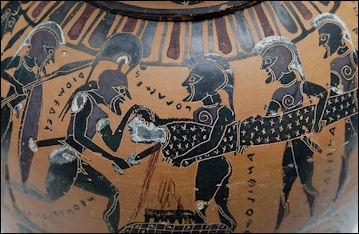
human sacrifice at PolyxenaIn a commentary in her blog a Don's Life on modern neo-pagan revivals involving worship of the Greek gods, “As almost everyone who studies ancient Greek religion insists, the key centre of the whole religious system was sacrifice: it was the ritual of killing and sharing the animal that was, if anything, the “article of faith” that defined the ancient community of worshippers. And it was through sacrifice (rather than ecology) that ancient Greeks conceptualized their own place in the world---distinct from animals on the one hand and the superhuman gods on the other... Until these eager neo-pagans get real and slaughter a bull or two in central Athens, I shan't worry that they have much to do with ancient religion at all. At the moment, this is paganism lite."
The Greeks and Romans considered human sacrifice immoral and uncivilized. Homer, however, describes captured Trojan being thrown onto the funeral pyre with the slain Greek soldiers under Achilles command.
Delos

priestess of Delphi by CollierDelos (near the the island of Mykonos) was the legendary birthplace of Apollo and the religious and political center of the Aegean for over a 1000 years. Today the uninhabited island is one huge archeological site. Most of the ruins aren't much more that well preserved foundations with a column here and a row of half-columns there but there some exceptions.
Most of the temples were dedicated the sun god and there is one place where four temples honoring him are located together, the oldest the "House of the Naxians" dates back to the 7th century B.C. Standing at the temple and looking to east you can see the remains of long narrow building called the "Sanctuary of the Bulls."
To the north is the Sacred Lake which is guarded by the Lions Way which contained nine huge archaic stone lions. About a half a kilometer from the site of the old Sacred Lake are the ruins of a stadium, and on a hill called Mount Kynthos are the remains of a sanctuary dedicated Zeus and Athena. One reason visitors can not stay on the islands is that in the old days people used take whatever they fancied home with them.
Oracle of Delphi
The Oracle at Delphi was a woman. She was required to be a virgin over the age of 50 but dressed as a maiden. When she performed her prophecies, she drank from a sacred spring, enveloped by vapors, and then returned to a basement in the temple, where she sat on a three-legged stool and chewed sacred laurel leaves. She received her messages from a mythical snake and chanted in a language that was interpreted by a priest and believed to be the words of the god Apollo.
The oracles had a reputation for saying what their customers wanted to hear. The scholar Michael Grants wrote that he Oracle's prophecies were conservative and flexible. "Some have...preferred to ascribe the entire phenomenon to clever stage management, aided by an effective information system," he said. .Xenophobe reportedly ignored the advice of the Oracle of Delphi and took his troops deep into Persian territory, where they were trapped and massacred.
Delphi
.png) Delphi of Oedipus Rex fame was a real place where people went to have their fortunes told during a sacred ceremony.
Delphi of Oedipus Rex fame was a real place where people went to have their fortunes told during a sacred ceremony.
The temple of Delphi, where the oracle did her magic, was located about 120 miles from Athens on the slope of 2000-foot-high Mt. Parnassus at a place described as the navel of the Earth and the place where the gods descended to earth. Delphi is believed to have been a sacred spot as far back as 1500 B.C. and taken over by the Greeks around 1000 B.C. According to legend, Delphi was originally an oracle of an earth-mother goddess. It was later taken over by Apollo after he slew a she'dragon, named Python, who lived in a cave on Mt. Parnassus.
Alexander the Great and other leaders and influential people came from all over the Mediterranean, including Egypt, to Delphi for advice on politics. Slaves came to find out how they could please their masters. Parents inquired how they could cure their sons of love sickness and husbands wanted to find who was the father of their children.
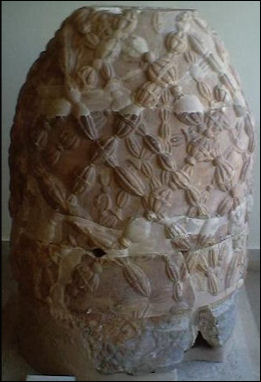
Naval of the worldDelphi became so popular that a large number of lodging houses and new houses opened up. The oracle was showered with gifts of silver and gold and became quite a wealthy woman. She stayed in business from 700 B.C. to 300 A.D. Delphi stopped functioning around the time of Rome became Christianized. Nero reportedly carted 500 statues from the site. It was officially shut down by Emperor Theodosius (379-95).
The Delphi ruins are beautifully situated on the southern flank of Mt. Parnassos which also offers panoramic views of the valleys below. The center of the sanctuary where the ceremonies were held is dominated by the Temple of Apollo which is composed of a platform with several columns sticking up from it. Next to the temple is fountain of water where the oracle would wash her hands before she touched the "sacred stone." Leading to the temple is the "sacred way" which used to be lined with treasurers, offerings and arcades. Northwest of the temple is the 5000-seat theater where ancient Delphic drama festivals were held every four years and up a hill from there is the stadium where the Pythian games were held which included competitions among philosophers as well as sporting events.
Delphi was originally an oracle of an earth-mother goddess that was later taken over by Apollo. Alexander the Great and other leaders came for advice on politics. Slaves came to find out how they could please their masters. Parents inquired how they could cure their sons of love sickness and husbands wanted to find who was the father of their children.
Ritual at the Oracle of Delphi
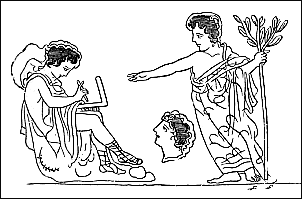 The ritual with the oracle of Delphi took place once a month. The oracle was bathed and purified at the nearby Casralia spring and was dressed in a long, elaborately-decorated robe and a laurel crown. The seers usually took written questions and gave yes or no answers. Two surviving lead tablets with the question remain. One is by Heracleidas who asked if his wife would give him children. The other by Cleotas asked if sheep raising was a good business to get into.
The ritual with the oracle of Delphi took place once a month. The oracle was bathed and purified at the nearby Casralia spring and was dressed in a long, elaborately-decorated robe and a laurel crown. The seers usually took written questions and gave yes or no answers. Two surviving lead tablets with the question remain. One is by Heracleidas who asked if his wife would give him children. The other by Cleotas asked if sheep raising was a good business to get into.
The ceremony began when the oracle, known as the Priestess of Apollo and the title Pythia, touched the egg-shaped omphalos ("sacred stone") which was considered the center of the world. After touching the stone she swallowed some laurel leaves and inhaled vapors from a chasm which caused her to go into a state of ecstacy.
While in this state she uttered incoherent words that a priest composed the into verses. These verses in turn were deciphered by interpreters, revealing the fortune. Whoever wished to consult the oracle had to offer a bull, a goat or a wild boar as a sacrifice. In the 5th century the oracle and the sacred stone were considered so valuable kingdoms fought wars over them.
Vapors at the Oracle of Delphi
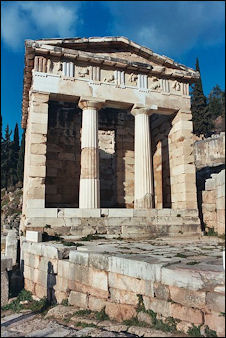
Oracle of Delphi TreasuryThe vapors that drove the oracle into a state of ecstacy were believed to be produced by the eternal decomposing of the flesh of Python. The first oracles were shepherd that lived in the area and inhaled the vapors and entered ecstatic states only to die afterwards. Later it was the decided that only special priestesses would be allowed to inhale the vapors.
The source of the vapors and what they were has been a point of research and contention among historians. Plutarch described a spring that emitted “fragrance and breeze” into the Oracle's temple, prompting the trances. Thorough searches in 19th and 20th century were unable to locate any springs like that in the Delphi area.
Research by John Hale, an archaeology graduate student at Cambridge, and Jelle de Boer, a Wesleyan University geologist mapped the area and found that two major faults intersected beneath the Oracle's grounds and theorized that limestone deposits below the grounds released gases---specifically methane, ethane and ethylene---into the air. Ethylene in particular caught their interest because it has a sweet smell and can “induce a trance” in low doses, producing an “anesthetic state twice as fast as nitrous oxide." Analysis of the spring water did find the presence of ethylene in the water, supporting the claim. Further research by Italian scientists led them to conclude that methane-induced oxygen deprivation was the trigger of the trances.
Siwa Oracle
There were other seers and oracles. The one in Aegira drank bull's blood before predicting the future. The one in Argos drank lamb blood. Seers also looked for omens in the way birds flew, spiders walked and chickens pecked. Alexander traveled by camel to get to the Siwa in present-day Libya to visit the oracle at the temple of Amun. "Amun was a god of prophecy," wrote adventurer and journalist Mark Asher in the Washington Post. "So valued was the presence of the Siwan oracle that Athens---a major power of that day---kept a special galley on permanent standby to take their messengers across the seas."
"The Athenian general Cimon, laying siege to Cyprus in 445 B.C., sent a delegation here, to whom the oracle accurately predicted the general's own death. Cleopatra, torn by her love affair with Antony sought advise here; so did Hannibal of Carthage, and the Spartan general Lysander. Herodotus, the Greek historian, arrived here in the 5th century B.C., and immortalized the tale of the mad Persian King Cambyses II, whose vast army was swallowed up by the Sea of Sand. The oracle predicted the victory of the athlete Eubtasi the 93rd Olympiad, and so assured was Eubotas of the laurels that he ordered a victor's statue of himself before the event...Alexander the Great---broke off from his campaign against the Persian King Darius to find out from oracle whether he was truly the son or a god."
"The oracle was not a man, but a shapeless peduncle of plaster, probably representing a human shrouded for burial in the upright manner favored by the ancient Libyans. Before the consultation, a throng of priests would parade through the palmeraries in a silver bark, followed by a procession of maidens whose pious hymns were intended to induce a favorable prophecy. the petitioner would then be drawn into the secret recesses of the temple, where the god's deliberations were relayed to him by the priests. We shall never know precisely what was revealed to Alexander, though it is recorded that the chief priest addressed him as "Son of Zeus."
Ancient Greek Ideas About the Afterlife and the Soul
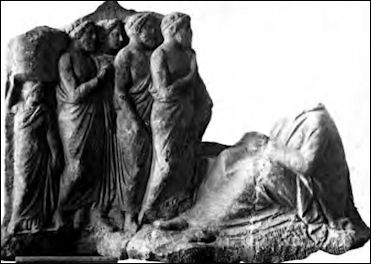
EleusisThe Greek concept of the soul changed over time. In the early days there were several souls, each with a different name and function, often residing in a particular part of the body. Thymos, for example resided in the chest and encompassed emotions, courage, fear and grief. Noos was associated with the mind and intellectual activity. It too was located in the chest.
The most important soul was the psyche. It was a breathy nebulous, spiritual soul that left the body when a person died. The word “psyche” comes from the Greek word meaning “to breath." The Greek believed that the psyche of everyone went to Hades after they died. In the early days the psyche was portrayed as a kind of weak, moribund ghost. Later on vases it was depicted as a small winged figure.
Some myths such as Persephone and Demeter describe a kind of reincarnation. Some of the philosophers, notably the Pythagoreans, talked about the transmigration of souls (See Pythagoreans Under Philosophy). Other philosophers saw the psyche as a kind of supreme force that was connected to forces that ruled the universe.
Plato developed the concept of an immortal soul that would shape concepts of death and afterlife in Western philosophy. His concept of the soul was connected with his view of higher order of reality beyond that in the perceived world. His concept of death was similar to that of reincarnation. After death, a soul enriched by knowledge and notions of good, beauty and justice, Plato theorized, rose to higher planes in the universe. For most mortals though there was a judgment, some rewards and punishments, and then rebirth centuries later on earth.
In Phaedrus , Plato wrote: for “the soul of a sincere lover of wisdom, or of one who has made philosophy his favorite...these, in the third period of a thousand years, if they have chosen this [philosopher’s] life thrice in succession, they thereupon depart, with their wings restored in the three thousandth year. Others are tried, some are sentenced to places of punishment beneath the Earth...others to some region in heaven...in the thousandth year they choose their next life."
By the A.D. 3rd, century the neo-Platonist, like early Christians, believed the soul was a "fiery breath" that tended or rise towards heaven but became damp and heavy in the Earth's atmosphere and was further weighted down by passions until it was brought down to earth. Many ordinary people believed in idea of the Islands of the Blest, a heaven with plentiful supplies of food and wine.
Hades
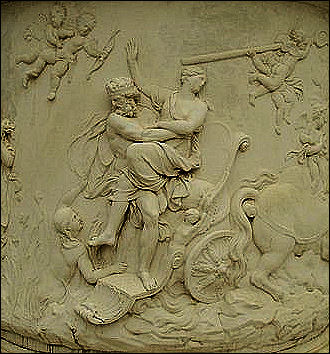
Perserpone with HadesHades was both the name of the Greek Underworld and the god that presided over it. After usurping the throne Zeus repelled attacks by giants and conspiracies by other gods. After the dethronement of the Titans a lottery with himself and his brothers Poseidon and Hades was held to decided who would occupy the heavens, the sea and the Underworld . Zeus won. He chose the heavens while Poseidon and Hades were awarded the sea and the Underworld respectively. The word “Hades” came from the Greek term a des , meaning “the unseen” or concealed. It inhabitants were known as ‘shades."
As a place Hades was a depressing Underworld where people went after they died. It wasn't hell. It wasn't a place of punishment for the wicked. It was more like purgatory. It was a place everyone went. No one received extreme forms of punishments other than famous mythological figures like Tantalus, Ixion and Tityos. Tantalus was a friend of Zeus who betrayed him and was condemned to the Underworld, where he sat for eternity next to a pool of water and fruit trees but was unable to drink or eat.
Tartarus in the Underworld was a hell-like place but only certain gods, not mortals, were sent there. Greece was so filled with wicked people that philosophers wondered whether the Underworld was large enough to accommodate all the ones who died since the beginning of time. This gave rise to the belief that maybe Tartarus was is in the southern hemisphere not underground, which in turn discouraged explorers from heading south. The Roman historian Pliny pointed out that it was also strange that even though the route to Hades was well-mapped no miners ever came across it. [Source: "The Discoverers" by Daniel Boorstin,"]
History of Hades and Myths Involving It
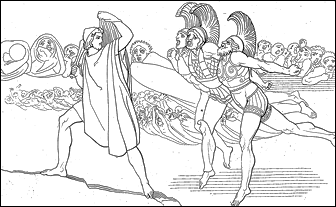
Odysseus in the UnderworldAround the six century B.C. the Orphic Greeks developed the mythology of the judgment which had been popular among the ancient Egyptians centuries before. Their Hades was governed by Pluto and Prosperpin and presided over by the judges Minos, Aeacus and Rhamadmanthis, the executioners and the Erineyes (See Below). Tartarus was a high-walled prison.
The early Jewish concept of Sheol and the later Christian concept of Heaven and Hell were partly based on the Greco-Roman belief of Hades. In the 4th century B.C., the Greeks thought the Blessed went to paradise-like Elysian Field. One of the first people to suggest the after death the soul was freed from the flesh and there was a judgement in which the Blessed were selected for the Elysian Fields was Plato.
The concept of Hades is closely associated with the myth of Orpheus.
See Orpheus and Eurydice and Demeter and Persephone Under Myths
Journey to Hades and the Dead
The Greeks believed that the soul was weak and lifeless and needed help to get to Hades. For a long time Hermes performed this duty. Sometimes on the journey the souls were harassed by the Furies. There are also stories about the Erinyes---old hags with snakes for hair, dog heads, black bodies, bat wings and bloodshot eyes---attacking people who had committed particularly nasty crimes such as killing their mother or knocking the sun off course. Once in the Underworld the soul was only a memory of itself
The first thing the Dead had to do when they arrived in the Underworld was cross the river Styx. Greeks traditionally put a coin in the mouth of the dead so they could pay the ferryman to get across the river. After making the crossing the good and the bad walked to the Nether World court where their fate was decided in a "Judgement Day" kind of arrangement by all-knowing judges. The bad sent to the left across the river of fire to the torture chambers of Tartarus and the good were taken to the right towards the blissful Elysian fields. [Source: "The Discoverers" by Daniel Boorstin,"]
Describing Odysseus's encounter with his mother in Hades in the Odyssey , Home wrote: “I tried to find some way of embracing my poor mother's ghost. Thrice I sprung towards her and tried to grasp her in my arms, but each time she flitted from my embrace as it were a dream or phantom." When Odysseus asked his mother why she didn't try to embrace him she explained: “All the people are like this when they are dead. The sinews no longer hold the flesh and bones together, these perish in the in the fierceness of consuming fire as soon as life has left the body, and the soul flirts away as though it were a dream."
Only later did the idea of a happy afterlife evolve. At first this was only reserved for great heros like Achilles, Menelaus and Diomedes. And later than this it became a place that members of cults who had special rites could go and later than this, ordinary people if they were good.
Image Sources: Wikimedia Commons, The Louvre, The British Museum
Text Sources: New York Times, Washington Post, Los Angeles Times, Times of London, Yomiuri Shimbun, The Guardian, National Geographic, The New Yorker, Time, Newsweek, Reuters, AP, Lonely Planet Guides, Compton's Encyclopedia and various books and other publications. Most of the information about Greco-Roman science, geography, medicine, time, sculpture and drama was taken from "The Discoverers" [∞] and "The Creators" [μ]" by Daniel Boorstin. Most of the information about Greek everyday life was taken from a book entitled "Greek and Roman Life" by Ian Jenkins from the British Museum [||].
No comments:
Post a Comment